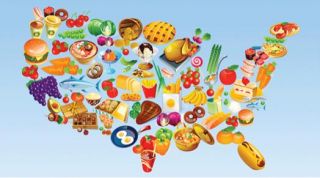
According to a recent food and health survey, 52% of Americans polled believe it’s easier to do their taxes than to figure out how to eat healthfully. Knowing how complicated our tax codes are, this means that eating healthy can really, really be tricky for many people. As a country in a battle with obesity, it is clear that healthy eating isn’t easy. Over a third of the American population is classified as obese; this means that almost 41 million women and more than 37 million men aged 20 and older were obese in 2010. However, obesity statistics do not encompass the entire picture. When we combine statistics on Americans who are obese or overweight, we find that more than 2 in 3 adults are considered to be overweight or obese. That is, sadly, a lot of us.
Why are the statistics on America’s prevalence of overweight and obesity so dismal? There are many factors that contribute to increased body weight and obesity. One of the main culprits is our diet. There has been a dramatic decrease in the quality of our diets as we went from a nation that relied on procuring food from local farms to one that mass-produces and prepackages most of what we eat. This transition in food production has affected food consumption, causing food to be readily available, with little effort on our part, pretty much everywhere we go. Also, the foods that are readily available tend to be high in calories, sugars and fat, all of which contribute to added weight. From the sugary snacks in the break room to the omnipresence of fast food chains, the quantity and quality of our diets have evolved such that we can eat unhealthy foods virtually non-stop. In many ways, an obesity epidemic was imminent.
First, let’s talk about quantity. The amount of calories a person needs per day is highly specific to each individual, depending on gender, age, height, and level of daily activity, however, the benchmark number, as seen on food labels, is approximately 2,000 calories per day (a number that may be more than the limit for sedentary or smaller individuals). 2,000 calories may seem like a lot, but many can consume 2,000 calories in just a matter of a few hours. For example, having lunch and dinner at many of today’s chain restaurants (e.g. P.F. Chang’s, Cheesecake Factory, Arby’s, Olive Garden, etc.) can not onlycause you to reach the 2,000 calorie limit, but, with many of their dishes, cause you to pass the caloric limit in just two meals!And this isn’t just something that happens when we eat out. Many prepackaged meals that we prepare at home also can rack up our daily calorie intake beyond what we really need.
In order to calculate the average amount of daily calories consumed by each American, many organizations use the amount of food availability per person as proxies for amount of food consumed. In the U.S., the amount of food available is enough to provide each person with approximately 3,800 calories per day. Even when taking into account the amount of food that is probably wasted or discarded per day, the average American is predicted to be consuming approximately 2,700 calories each day! (Note: a 5’5” woman weighing about 140 pounds and leading a somewhat active lifestyle would still only need about 2,200 calories maximum per day).
Next, let’s discuss quality. Growing up, most of us learned from our parents or teachers about what types of foods are good for us and what types are not. The message was pretty simple: Fruits and vegetables are good, sugars and sweets are bad. The rest of the foods we eat (including meats, dairy products, and grain/flour products) wasn’t always so clear, but should be consumed in moderation.Even though this type of “healthy eating”that was engendered into us from a young age is what we know in theory, in practice we do not seem to follow this advice. This is evident because, according the U.S. Department of Agriculture, the top 5 sources of daily calories among American adults are as follows: grain-based desserts (138 kcal), yeast breads (134 kcal), chicken and chicken mixed dishes (123 kcal), soda/energy/sports drinks (112 kcal), and alcoholic beverages (106 kcal). This means that of the top 5 most consumed foods by American adults consist mostly of refined grains or sugars. In fact, only 8% of the average American diet seems to consist of fruits and vegetables. Moreover, no single fruit or vegetable is among the list of the top 25 foods consumed daily by adults or children, unless you count fried white potatoes, aka “French Fries”(52 kcal- youths; 46 kcal- adults), which we all know don’t count as a vegetable!
So what does make up the majority of the American diet? According to a 2010 USDA study, Meats, eggs, and nuts make up 21% of our diets, dairy products make up 9%, flour and cereal products are 24%, added fats and oils are 23%, and caloric sweeteners are 14%. In other words, the foods we know, in theory, are not too good for us (refined carbs, added fats, and added sugars) are what, in practice make up about 61% of our diets!
So yes, we know that the amount and type food that we eat is a huge contributor to our obesity epidemic today, but many of us underestimate the complexity of how the foods we eat contribute to the problem of obesity/overweight in America. It isn’t just about cutting back on portion sizes, but also about questioning what it is that we are putting in our bodies, and understanding why what we ought to eat is not always what we tend to eat.
--
Dr. Nicole Avena is a research neuroscientist/psychologist and expert in the fields of nutrition, diet and addiction. She has published over 60 scholarly journal articles, as well as several book chapters on topics related to food, addiction, obesity and eating disorders. She recently edited the book, Animal Models of Eating Disorders (Springer/Humana Press, 2013), and she has a book Why Diets Fail (Ten Speed/Crown) available for preorder now and to be released in January, 2014. Her research achievements have been honored by awards from several groups including the New York Academy of Sciences, the American Psychological Association, the National Institute on Drug Abuse, and her research has been funded by the National Institutes of Health (NIH) and National Eating Disorders Association.
Website: https://www.drnicoleavena.com/
Twitter: https://twitter.com/DrNicoleAvena


